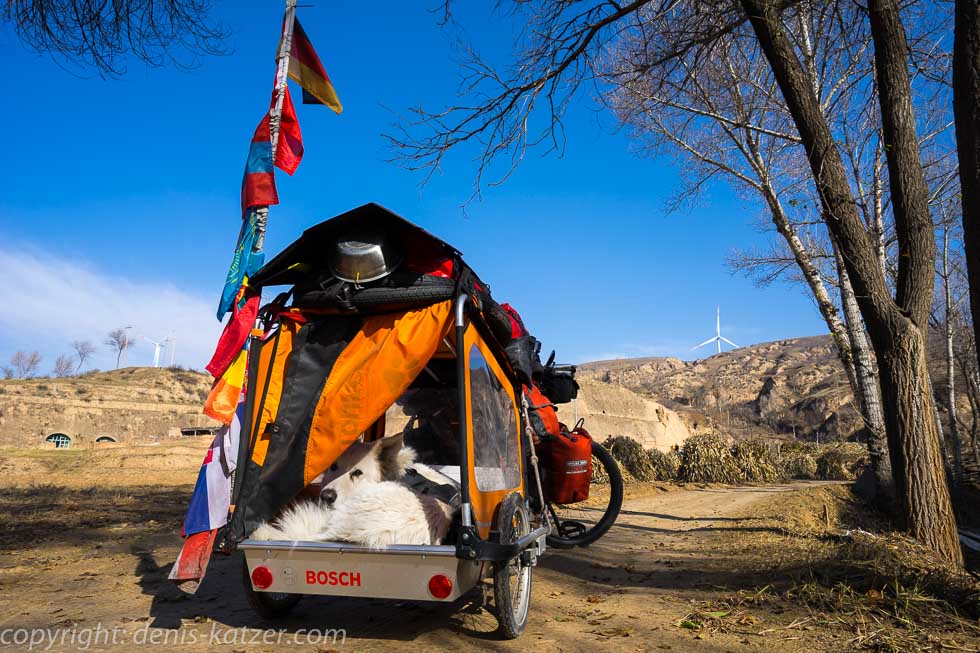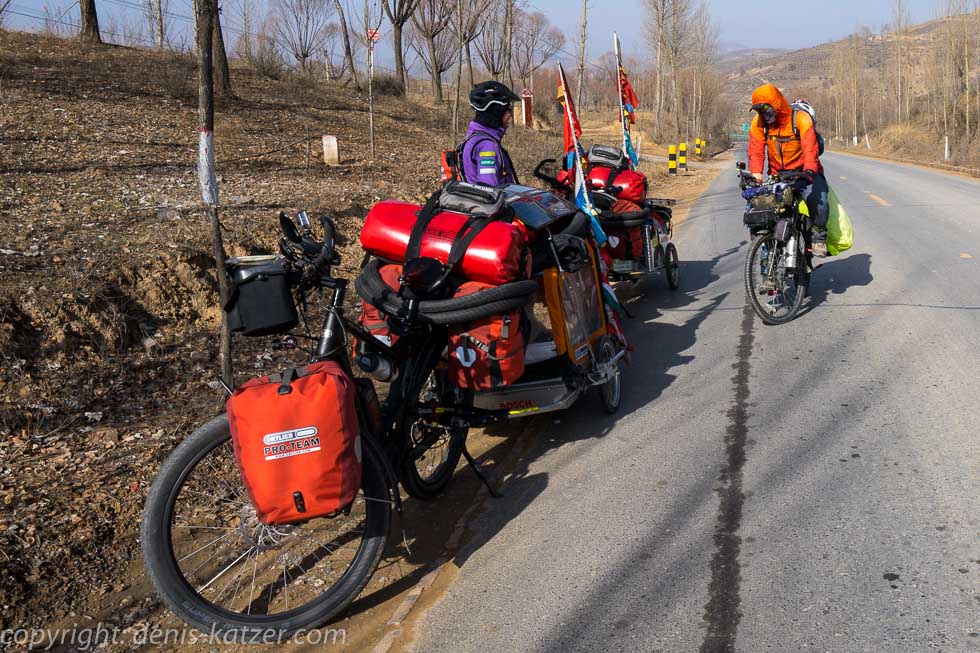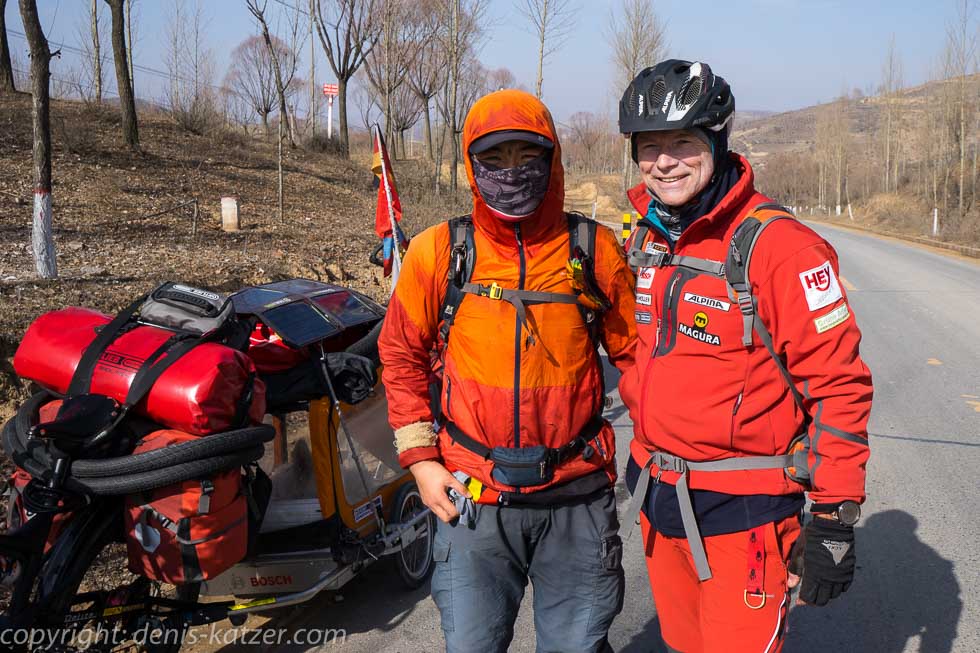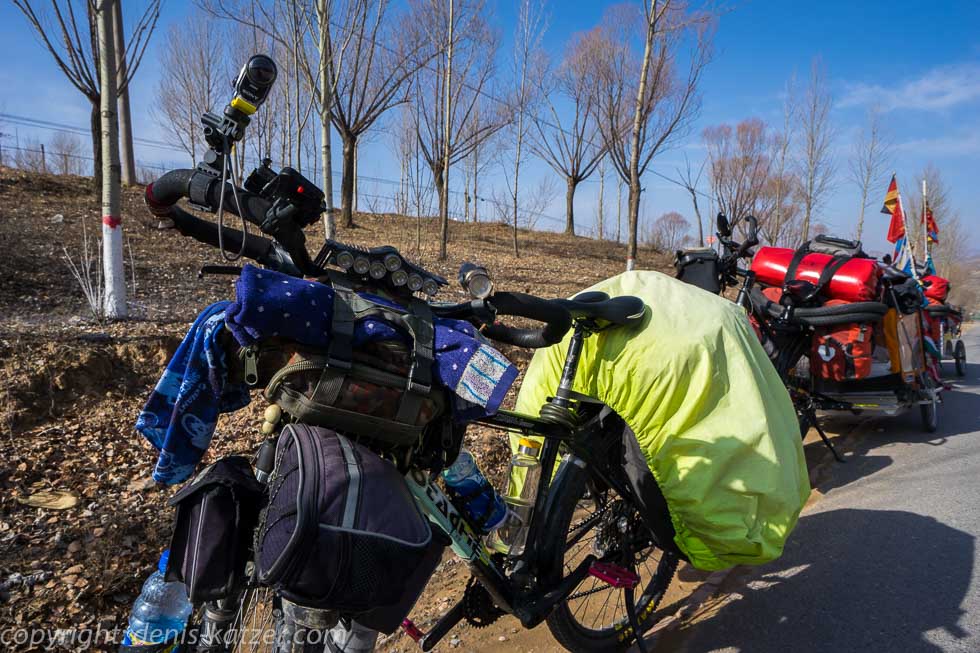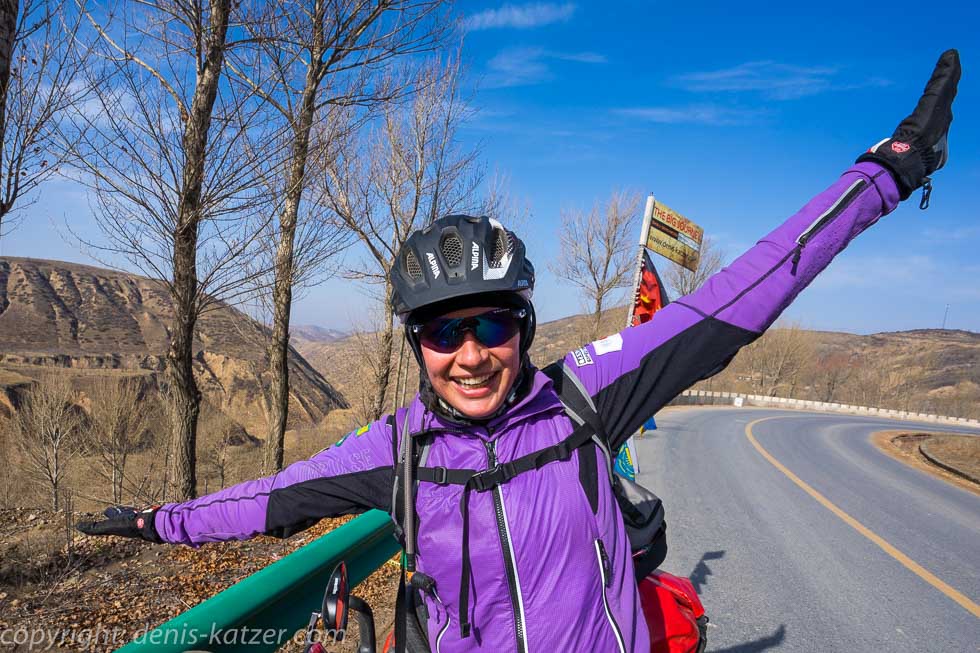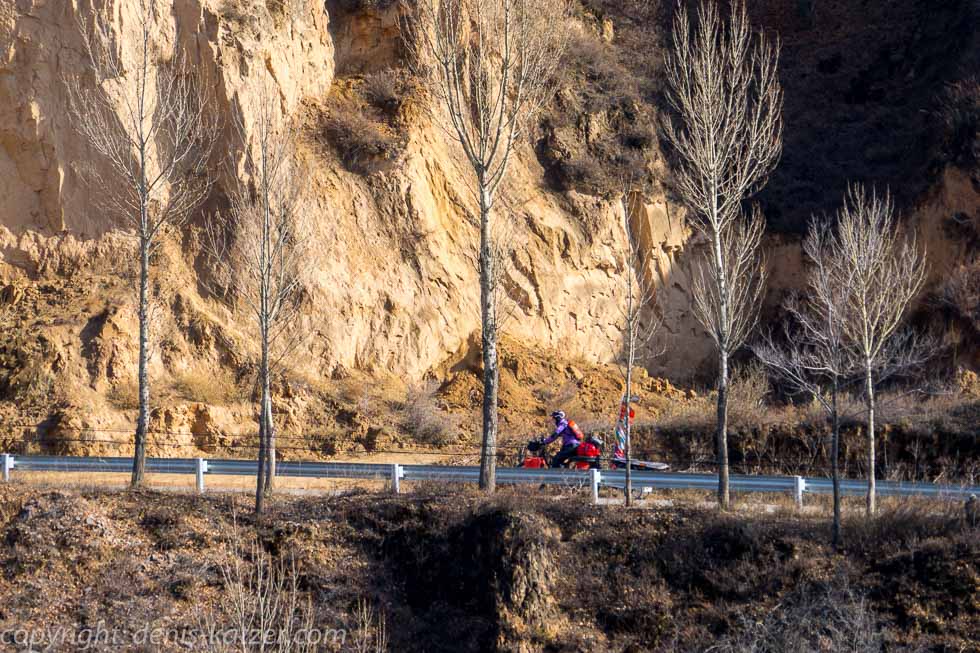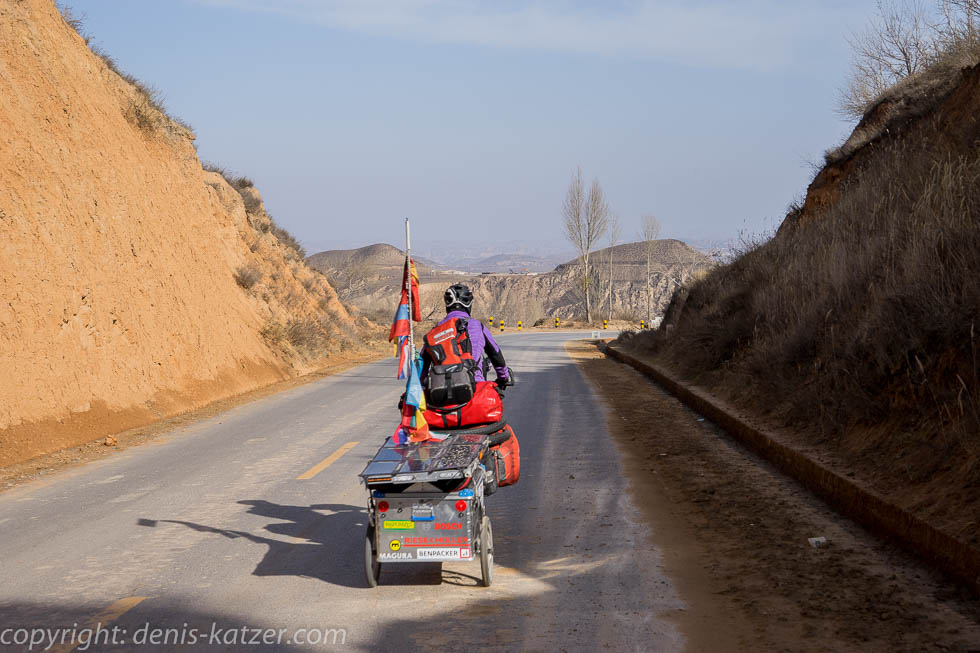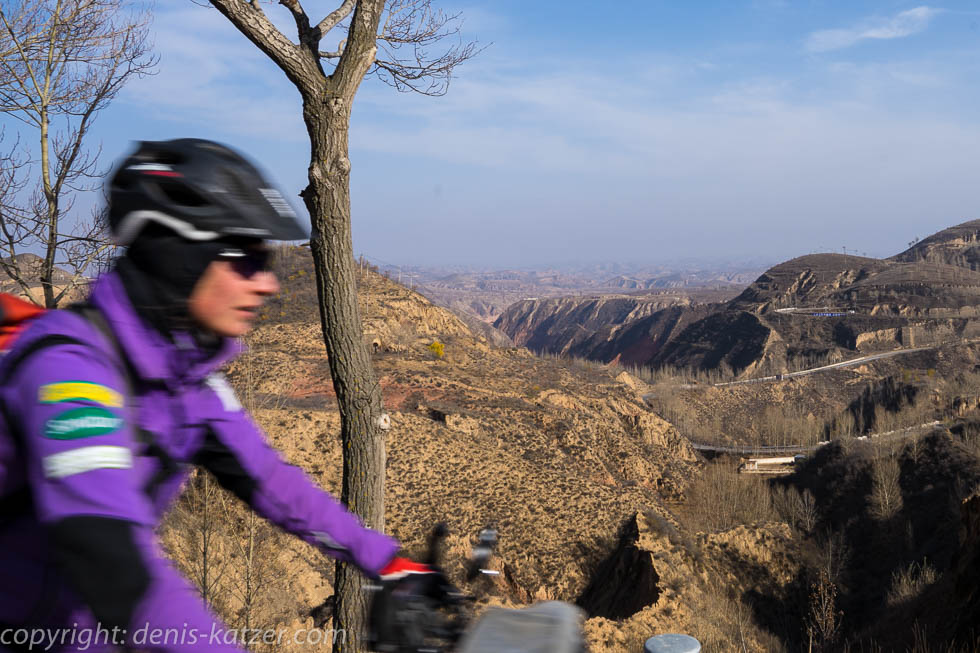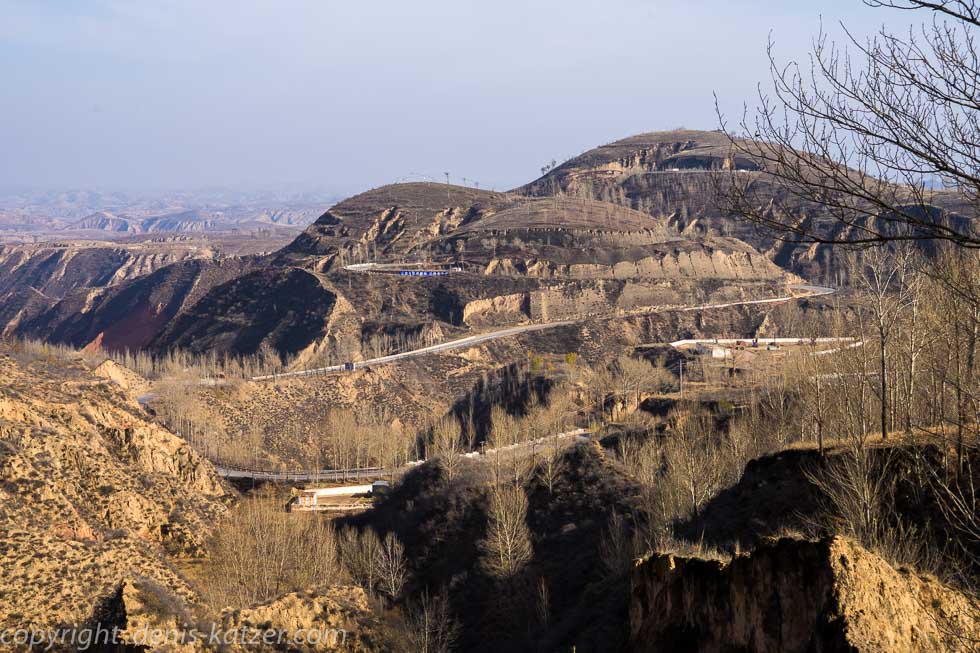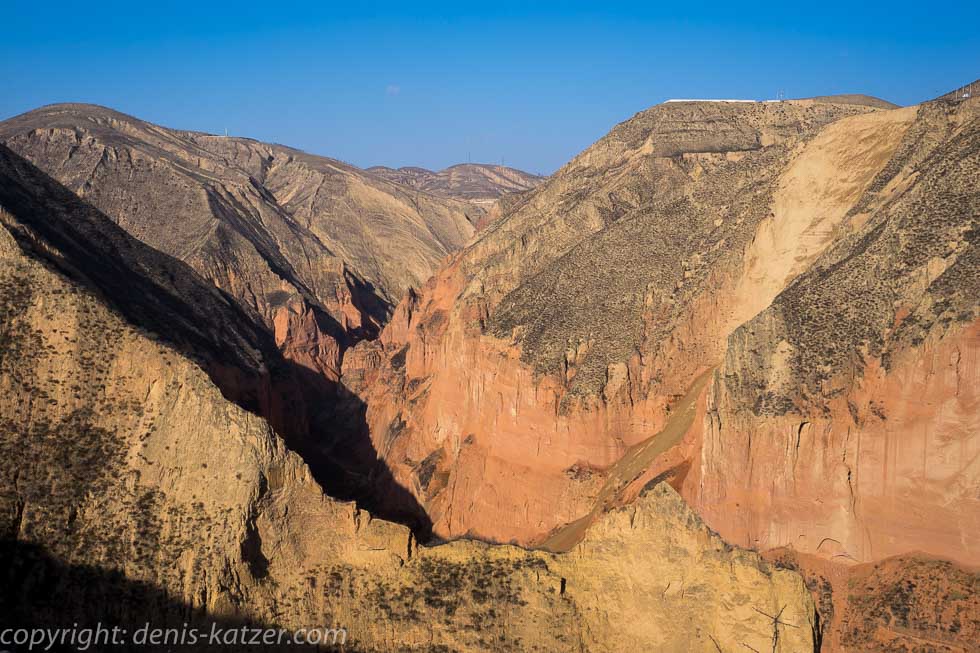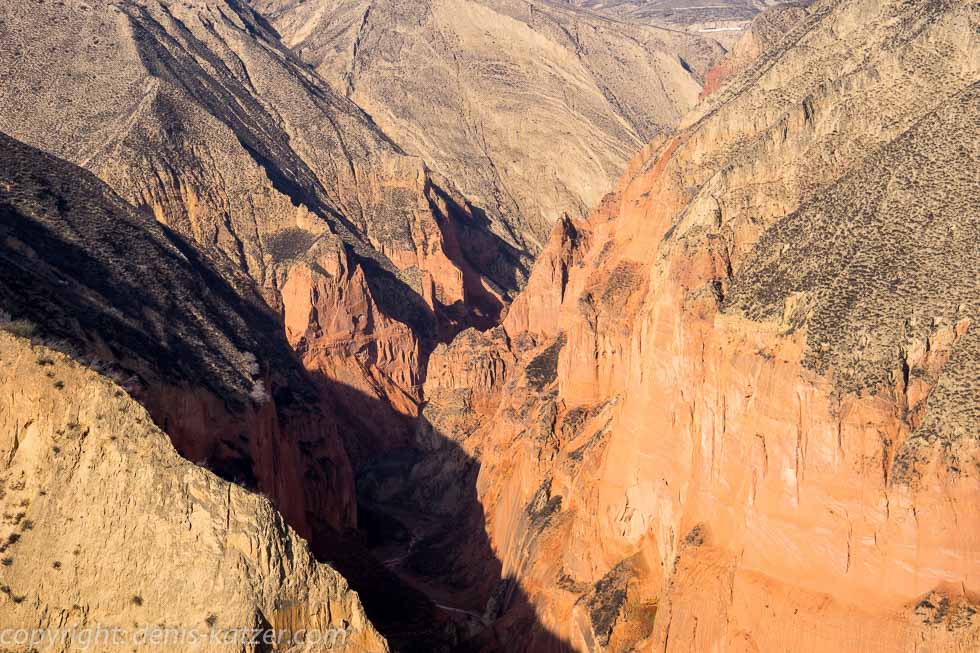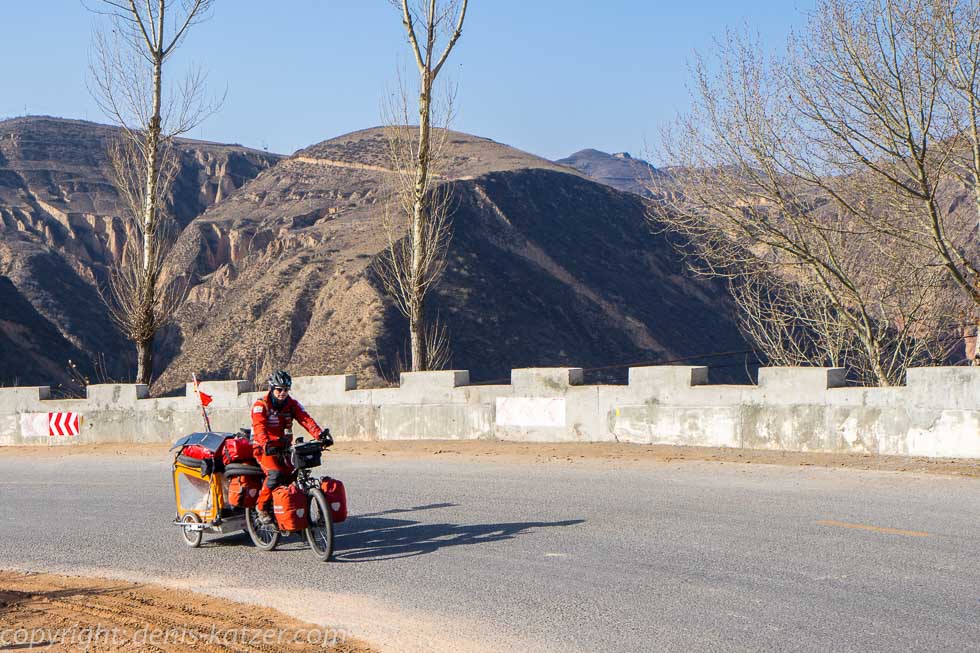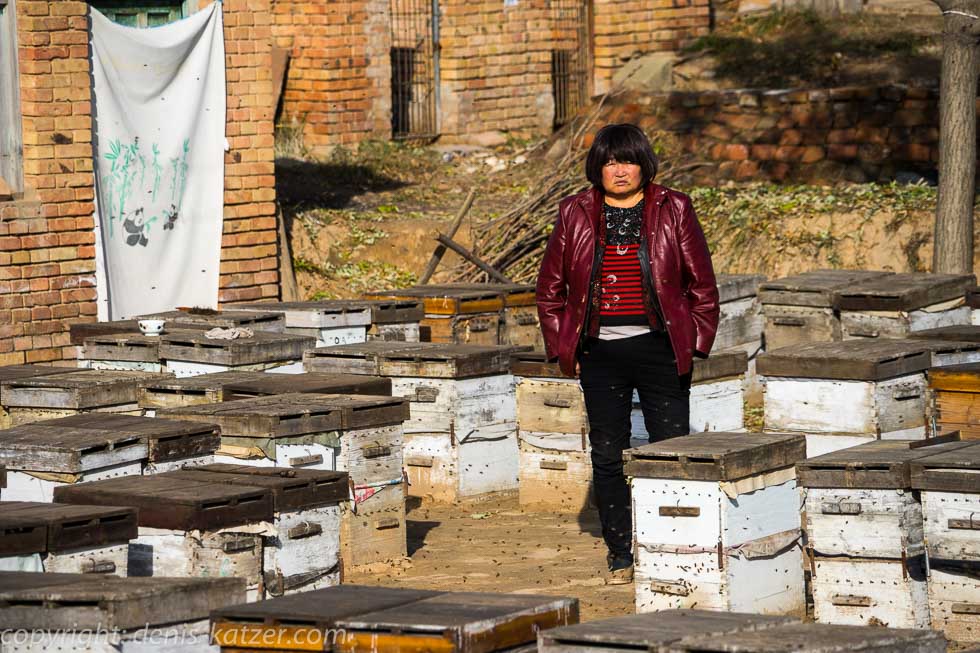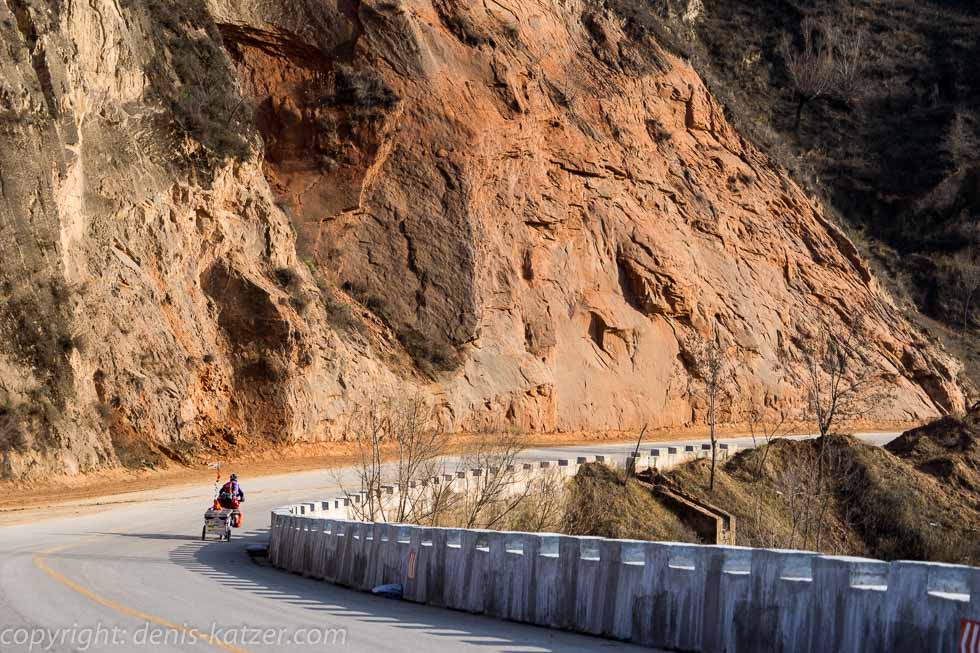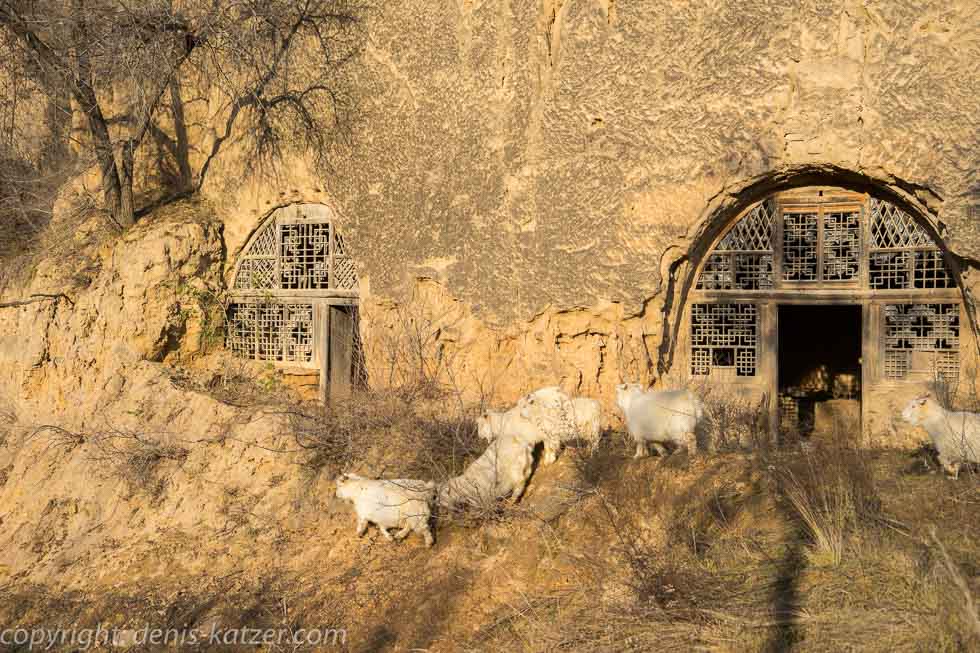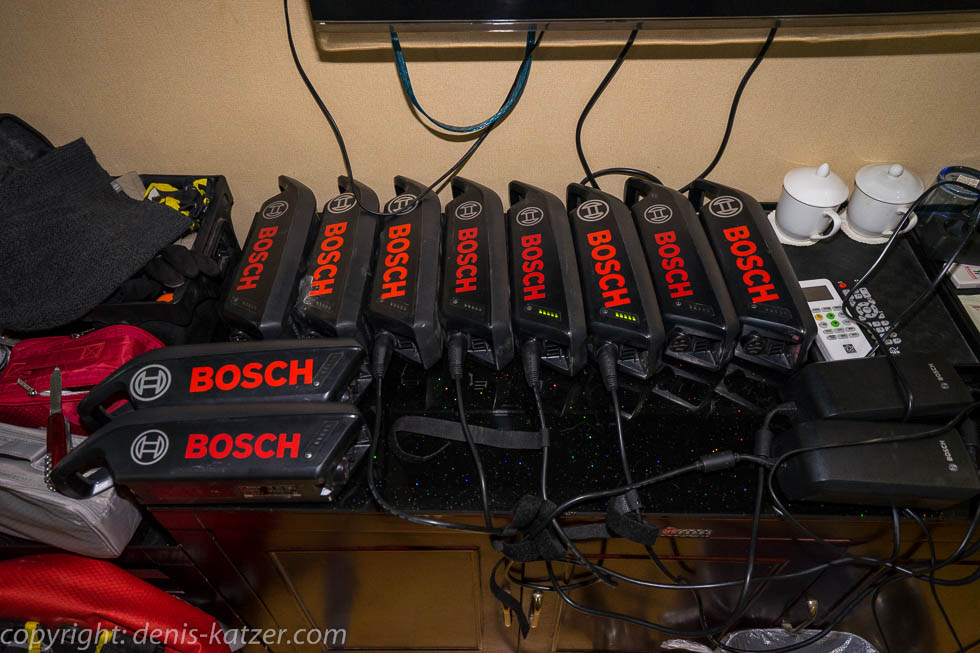
172 km of mountains – the highest demands on technique and body
N 36°51'42.1'' E 109°19'39.9''
Date:
19.11.2015
Day: 144
Country:
China
Province:
Shaanxi
Location:
Ansai
Latitude N:
36°51’42.1”
Longitude E:
109°19’39.9”
Daily kilometers:
128 km
Total kilometers:
10,970 km
As the crow flies:
92.10 km
Average speed:
23.4 km
Maximum speed:
53.6 km
Travel time:
5:27 hrs.
Soil condition:
Asphalt
Maximum height:
1.800 m
Total altitude meters:
10.821 m
Altitude meters for the day:
1.770 m
Sunrise:
07:23 am
Sunset:
5:32 pm
Temperature day max:
12 °C
Temperature day min:
1 °C
Departure:
09:30 a.m.
Arrival time:
7:00 p.m.
(Photos of the diary entry can be found at the end of the text).
With a maximum temperature of 12 degrees and wonderful sunshine, it is a perfect day for a cycle tour through China. Winter is still hot on our heels, but it hasn’t managed to catch up with us yet. According to my map study, the 650 km long and 172 km wide Qin-Ling mountain range lies in our path today, which we have to cross in its entire width. Because it is quite lonely on this route, and the next accommodation is at least 128 kilometers away, a big challenge for us and our technology.
Just a few kilometers after we set off, the narrow road winds its way up towards the sky. Thanks to the additional six 500 watt Bosch batteries, we have the luxury of riding in turbo mode. We reach an altitude of 1800 meters at around 20 km/h. The landscape is breathtakingly beautiful. As in previous days, there are very few cars and almost no trucks on this route. Yes, there is also something like that in China. I enjoy the quiet whirring of the powerful Bosch motor, which tirelessly transfers the energy from the batteries to the chain and ensures that my 150 kg bike, including trailer and Ajaci, plus the 80 kg of my body, gets up the mountain ridge. While I was initially concerned that the incessant strain of such a journey could bring the engine to its knees, I am now all the more pleased with the reliability of the persistently working engine. At the top of the mountain, we glide along a 50-meter-wide ribbon. To our left and right, steep mountain slopes plunge into the depths. The pleasantly cool wind blows in my face. With a smile, I inhale the nature, the many small villages and farmers, some of whom sit on a wooden bench in front of their simple huts to chat with their neighbors. Every now and then I take a look behind to see if Tanja is still there. Her facial expression also tells me how much she is enjoying this wonderful day.
The ride on the mountain ridge offers us an indescribable panoramic view of the mighty Qin-Ling Mountains, which create a vegetation boundary between the south and north and at the same time form a watershed between the Yellow River and the Yangtze River. Does the mountain range also form a weather divide? Is it warmer on the other side? We will see. We have been told that the warmer, more humid areas begin on the southern side of the Qin Ling, where extensive forest regions alternate with rice fields.
“Is that a cyclist up ahead?” I shout, not really wanting to believe my eyes. “Could be,” Tanja replies. Every meter further on, the initially blurred silhouette turns out to be a long-distance cyclist whose bike is heavily laden. “Ni hao!” we greet in high spirits as we overtake him at considerable speed. “Ni hao!”, we hear a yelp. We know what it means to have to stop during a steep ascent, so we carry on for now. “It must have totally frustrated the poor guy when we rode past him so unsuspectingly on our monster bikes and trailers!” I shout to Tanja with a laugh. “Mean, actually!” she replies. “Absolutely mean. I think we should wait for him upstairs and have a few words with him.”
It takes ten minutes for our colleague to pull up next to us, panting loudly. He puts his bike on the stand, shakes our hands and says in good English, “My name is De.” “De?” I ask. “Yes, it’s an abbreviation. My real name is too difficult for you Europeans to pronounce,” he explains, still panting heavily. “The way you thundered up the mountain, you must be damn fit,” says De. “Ha, ha, yes, we’re fit. We’ve cycled the whole way from Germany to here.” “From Germany to here? Nothing surprises me anymore.” I give him a friendly wink and point to the Bosch engine. “What’s that?” De wants to know. “A small engine that helps us to get our horses and trailers to such heights so quickly,” I explain. “Now I understand. I was already doubting myself,” he laughs. During the conversation, we learn that De is from Beijing and, like us, is on his way to the southern province of Sichuan. We chat for a while, then continue our journey with mutual congratulations.
Every now and then I let my system rush down into the valley for a few hundred meters. I lean into the bends and have to make an effort not to succumb to the intoxication of speed. The suspension absorbs the rough bumps in the asphalt without any problems, absorbing every bump just like a motorcycle. It’s a dream to hammer down the pass road on such a robust, high-tech machine, which our bike certainly is. Despite the heavy load, it keeps exactly on track and does not start to lurch. This also poses a danger, as I don’t notice the constantly increasing speed. “Not so fast!” Tanja’s call warns me. To keep the speed under control, I have to put my foot down, or rather pull on the brake levers. Hard work for our Magura brakes. Under such tough conditions, the disc brakes guarantee us the necessary safety to reliably slow down the weight of 220 kg, including my body, from 50 km/h to 10 km/h in a short time. In some sections of the pass route, it even takes 10 or 20 minutes. The brake discs do not burn out and the braking performance is maintained at one hundred percent. Nevertheless, we take short breaks during long descents to give the braking system a chance to cool down a little.
Once we reach 1200 m, we work our way up again. In some places we have to shift down to third gear because of the enormous gradient. Clack, clack, clack, the Rohloff gearbox jumps into the right gear. It is fantastic how reliably this circuit works, because it is not a matter of course that a circuit retains its reliability and precision under such an enormous load. You might think at this point, “Aha, now he has to write a hymn of praise to his sponsors”, but far from it. So far, I am simply thrilled with the fantastic quality that our partner companies have equipped us with. This is simply world-class and is largely responsible for the joy we get from being able to explore and discover Mother Earth for ourselves in this way.
The up and down of my thighs and my steady breathing put me in a kind of trance. We sit comfortably on our Riese and Müller e-bikes and let our gaze glide over the mountain landscape, whose highest mountain, Taibai Shan, stretches its peak 3767 m into the blue sky. “Stop!” Tanja shouts behind me. “My battery is empty!” Because we drive in turbo mode, we blow out one of our batteries about every 25 km. As each of us has six of them in our luggage, we have a range of at least 150 km despite the mountains. With our joker, the charging by the GoalZero battery, even 165 km. In other words, more than we can cycle in daylight in winter and more than our strength allows. It’s a fantastic feeling to no longer be haunted by the fear of being stranded somewhere in the mountains without a power socket. With this range, we will certainly always make it to the next charging station. And when the temperatures become more pleasant, we are now able to pitch our tent somewhere and then find a power connection the following day. This means that we are now even freer and more independent than before and can enjoy the breathtaking mountain ride without a care in the world.
The farmers, who have been farming up here for ages, have removed entire mountain peaks in order to plant their fields on the plateau they created. Some of the mountains that have been trimmed in this way look like Ufolande sites. We apply the brakes, stop, take a few photos and drive on. Again and again our path leads through villages. Some of the residents are beekeepers, whose colonies live right next to the mountain road in small wooden boxes and buzz around in large numbers. Some of the mountain dwellers live in the rock caves that have accompanied us for 1000 kilometers. Then we reach a parking lot. Signs written in Chinese indicate a fantastic view. We park our bikes and walk with Ajaci to a wooden papillon. The sight amazes us and leaves us open-mouthed. It’s unbelievable what this country has to offer. The enormous gorges that open up before us, which the Qin Ling mountain range offers us at this point, remind me of the Grand Canyon in the US state of Arizona. We stand there in awe and inhale the indescribable beauty, diversity, variety, roughness and power of our Mother Earth.
It is already dark when we reach the small town of Ansai in the valley after 10 hours, 128 kilometers and 1780 vertical meters. Exhausted but happy, we stand in front of the hotel that we had already booked. While I start to unload the bikes, Tanja goes to reception to register us. It doesn’t take long for her to come back moaning. “What’s wrong?” I ask with an uneasy feeling, because we’ve often had difficulties checking into accommodation in recent months. “Stop unloading first and take a look at the stairs.” “Stairs?” I ask. “Yes, there’s a very steep, long staircase that leads to reception. I don’t know if we’ll be able to lug everything up there after such an exhausting day?” “Okay, I’ll check it out,” I reply and trudge off. In fact, the staircase described by Tanja stretches upwards directly behind the entrance. The sight of it is daunting and could certainly deter a normal traveler from having to lug his suitcases up there, let alone a cyclist who has just completed 128 kilometers of mountainous terrain and now has to carry about 300 kg to the top. “We’ve already managed quite different things,” I motivate Tanja, so we join forces to heave the saddlebags, bikes and trailers to the top. By the time we have everything in the lobby, we are soaked to the skin with sweat. Fortunately, the lady at reception gives us a room on the same floor directly behind reception. As we are only staying one night, we don’t mind that the room has no window, smells of smoke and is completely run-down. As always, I immediately plug the first empty batteries into my four-pin connector. “I can’t,” I say, startled. “What’s not working?” “Well, the batteries won’t charge,” I reply and try another socket. Our batteries can’t be charged there either. “What could be the reason for that?” wonders Tanja. “I suspect there’s not enough power coming out of the can.” I’ve already had this problem on the previous trip. Especially in small street restaurants, but in a hotel? I nervously walk back and forth and think about how I can solve the problem. Even if I connect only one energy storage unit, the charge indicator remains dead. “Oh man,” I groan, rubbing the sweat from my forehead and staring at the power collectors as the green charging lights of an accumulator suddenly start flashing. “Something’s happening!” I exclaim delightedly as all four batteries come to life one after the other. “That’s strange. I wonder why that is?” asks Tanja. “I don’t know, the main thing is that it works now,” I reply contentedly…
The live coverage is supported by the companies Gesat GmbH: www.gesat.com and roda computer GmbH www.roda-computer.com The satellite telephone Explorer 300 from Gesat and the rugged notebook Pegasus RP9 from Roda are the pillars of the transmission.

